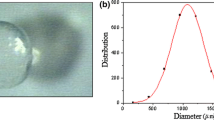Summary
Similar to alginate, pectate forms chelates with a number of divalent metal ions involving both carboxyl and hydroxyl groups. With most metals, the hydroxyl groups have to be present in vicinal pairs, i. e. belong to the same uronic acid residue. The strength of these chelates appears to be in the following order of decreasing stability: Cd2+ (?), Ba2+, Co2+, Ni2+, Mn2+, Cu2+, Sr2+, Ca2+, Mg2+. In most cases, the relative stability is close to the average value while in algin it spreads over a wider range indicating that the reaction with alginate is more specific to the metal ion than pectate is.
Experimental data indicate that both inter- and intramolecular chelates are formed. Presumably the formation follows an equilibrium with an equilibrium constant characteristic for each metal. The ratios of inter- to intramolecular forms apparently are in the following order: Cu2+, Ca2+ > Mg2+ > Ni2+, Sr2+ > Mn2+, Co2+, Ba2+ > Cd2+ > Zn2+. The same principle applies to alginate, and a similar order has been obtained from previous data. However, alginate favors the intermolecular, cross-linking form more than pectate does.
Zusammenfassung
Pektat bildet, ähnlich wie Alginat, Chelate mit einer Anzahl von zweiwertigen Metallionen, indem das Metall Bindungen sowohl mit Carboxylgruppen als auch Hydroxylgruppen eingeht. Für die meisten Metalle müssen die Hydroxylgruppen in vizinalen Paaren vorhanden sein, d. h. dem gleichen Uronsäurerest angehören. Die Stabilität dieser Chelate scheint in der folgenden Reihenfolge abnehmender Stärke vorzuliegen: Cd2+ (?), Ba2+, Co2+, Ni2+, Mn2+, Cu2+, Sr2+, Ca2+, Mg2+. In den meisten Fällen liegen die Werte der relativen Stabilität in der Nähe des Durchschnittswertes während sie in Alginat stärker voneinander abweichen. Das weist darauf hin, daß die Chelatbildung von Alginat mit Metallionen spezifischer ist als die von Pektat.
Experimentelle Ergebnisse deuten darauf hin, daß sowohl inter- als auch intramolekulare Chelate gebildet werden. Vermutlich erfolgt die Bildung bis zu einem Gleichgewicht mit einer Gleichgewichtskonstanten, die für das jeweilige Metallion charakteristisch ist. Die Verhältnisse von interzu intramolekularer Form scheinen in folgender Reihenfolge vorzuliegen: Cu2+, Ca2+ > Mg2+ > Ni2+, Sr2+ > Mn2+, Co2+, Ba2+ > Cd2+ > Zn2+. Das gleiche Prinzip gilt auch für Alginat, und es wurde mit Hilfe von früheren Ergebnissen eine ähnliche Reihenfolge erhalten. Alginat jedoch begünstigt die intermolekulare, vernetzte Form weit mehr als Pektat.
Similar content being viewed by others
References
Schweiger, R. G., J. Org. Chem.27, 1789 (1962).
Schweiger, R. G., J. Org. Chem.29, 2973 (1964).
Schweiger, R. G., Kolloid-Z.196, 47 (1963).
Lefèvre, K. U. andB. Tollens, Chem. Ber.40, 4513 (1907); method modified byW. H. McNeely, Kelco Company (unpublished data).
Author information
Authors and Affiliations
Rights and permissions
About this article
Cite this article
Schweiger, R.G. Metal chelates of pectate and comparison with alginate. Kolloid-Z.u.Z.Polymere 208, 28–31 (1966). https://doi.org/10.1007/BF01499863
Received:
Issue Date:
DOI: https://doi.org/10.1007/BF01499863



